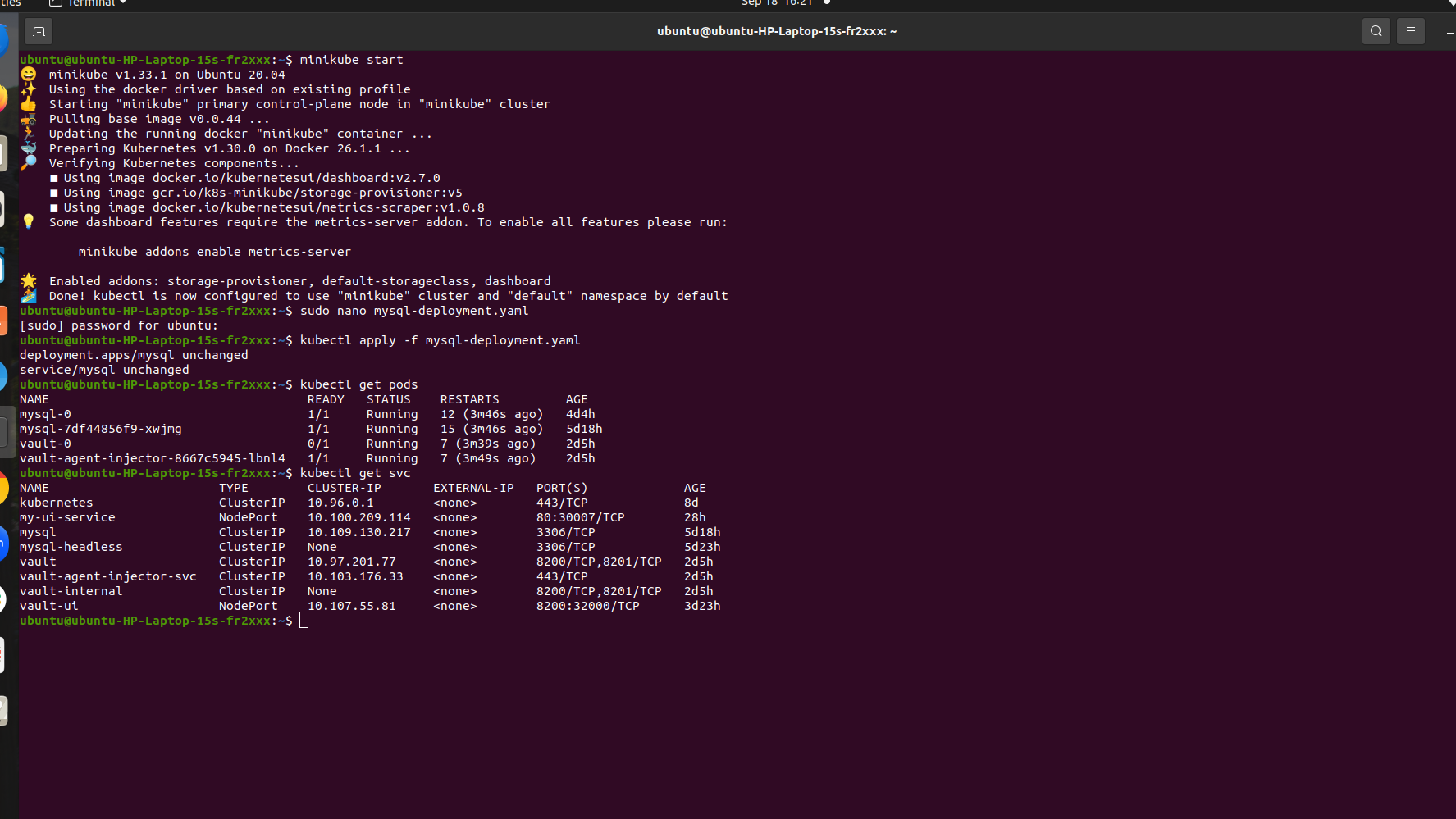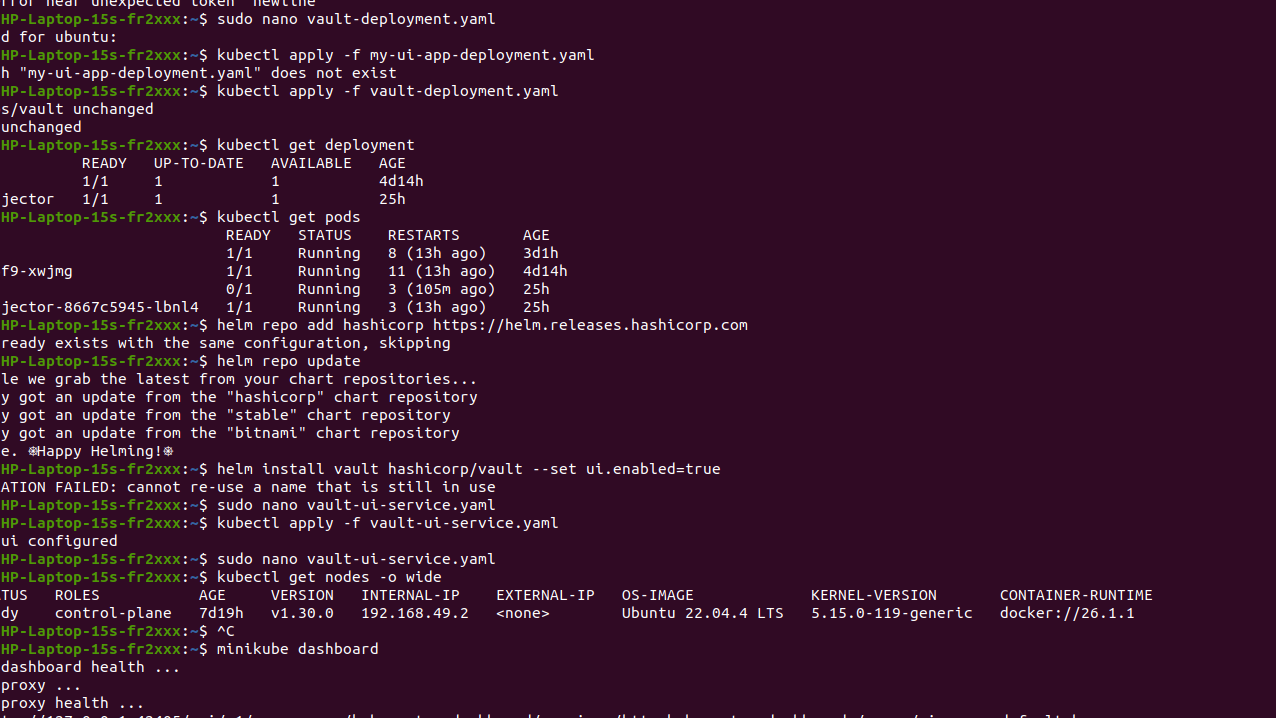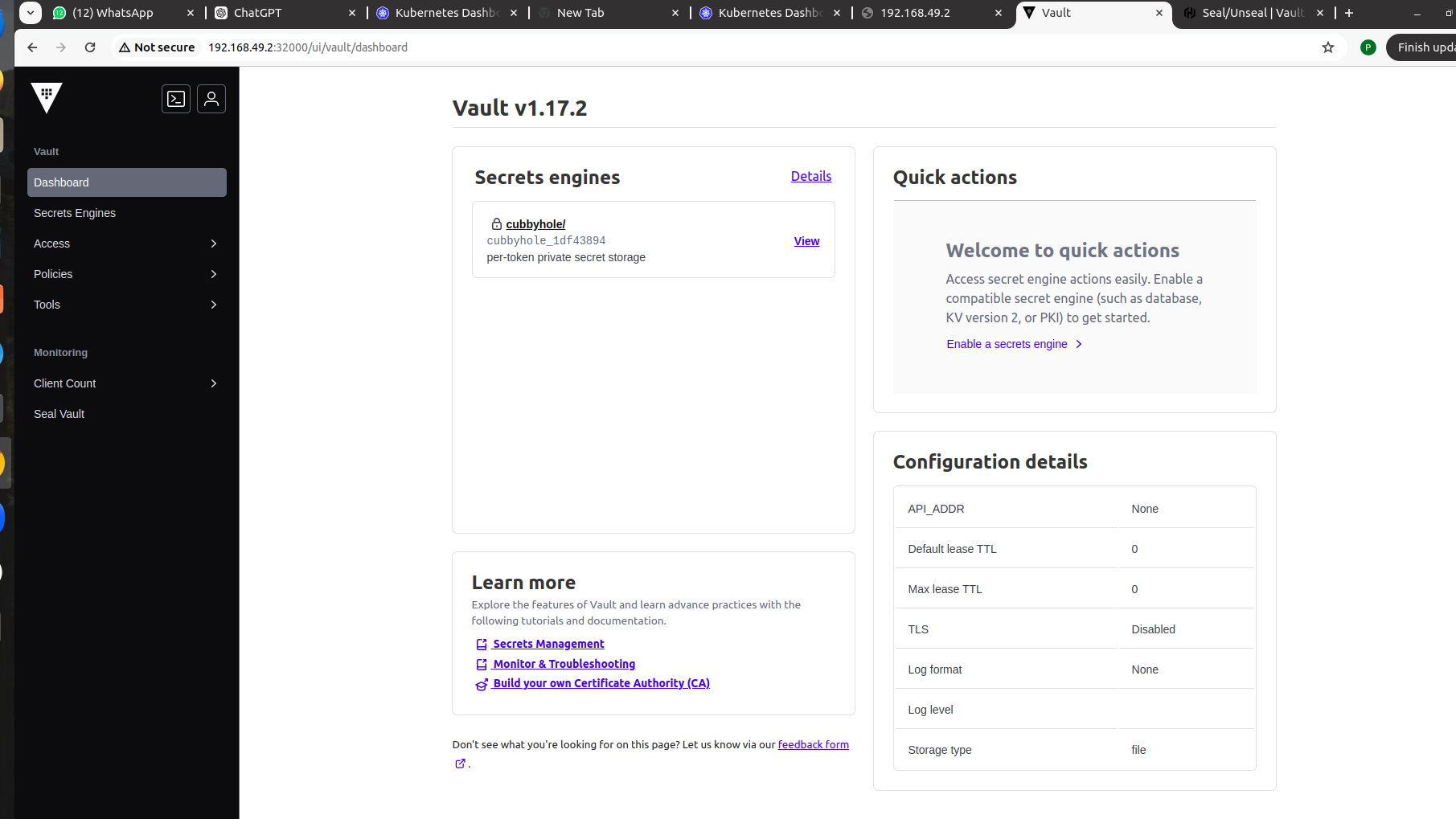Introduction:
What is Vault?
HashiCorp Vault is an open-source tool designed to securely store, manage, and access secrets (such as API keys, passwords, certificates, and encryption keys) in modern distributed systems and cloud-native environments. It provides centralized secrets management, encryption as a service, and secure access management for any infrastructure, application, or service.
Prerequisites:
Before you begin, ensure you have the following:
- A running Kubernetes cluster (Minikube, EKS, GKE, etc.)
- Helm 3.0+ installed
kubectlinstalled and configured- MySQL deployed in Kubernetes
- MySQL credentials ready
Step 1: Deploy MySQL in Kubernetes
apiVersion: apps/v1
kind: Deployment
metadata:
name: mysql
spec:
replicas: 1
selector:
matchLabels:
app: mysql
template:
metadata:
labels:
app: mysql
spec:
containers:
- name: mysql
image: mysql:5.7
env:
- name: MYSQL_ROOT_PASSWORD
value: rootpassword
- name: MYSQL_DATABASE
value: vaultdb
- name: MYSQL_USER
value: vault
- name: MYSQL_PASSWORD
value: vaultpassword
ports:
- containerPort: 3306
---
apiVersion: v1
kind: Service
metadata:
name: mysql
spec:
ports:
- port: 3306
selector:
app: mysql
2. Apply the MySQL Deployment
kubectl apply -f mysql-deployment.yaml
3.Verify the MySQL Pod
Check if the MySQL pod is running:
kubectl get pods
Also, check if the MySQL service is exposed:
kubectl get svc

Step 2: Install Helm and HashiCorp Vault Helm Chart
1.Add the HashiCorp Helm Repository:
helm repo add hashicorp https://helm.releases.hashicorp.com
2. Update Helm Repository
helm repo update

3. Install Vault using Helm:
Create a vault-values.yaml
server:
extraEnvironmentVars:
VAULT_LOG_LEVEL: "debug"
ha:
enabled: false
storage:
mysql:
address: "mysql:3306"
username: "vault"
password:
secretRef:
name: mysql-root-password
key: password
database: "vault_db"
server:
securityContext:
capabilities:
add: ["IPC_LOCK"]
Install Vault with the custom values file:
helm install vault hashicorp/vault -f vault-values.yaml
Verify Vault Installation
kubectl get pods
kubectl get svc

4. Deploy Vault StatefulSet deployment:
create vault-statefulset.yaml
apiVersion: apps/v1
kind: StatefulSet
metadata:
name: vault
namespace: default
labels:
app: vault
spec:
serviceName: "vault"
replicas: 1
selector:
matchLabels:
app: vault
template:
metadata:
labels:
app: vault
spec:
containers:
- name: vault
image: hashicorp/vault:1.10.0
ports:
- containerPort: 8200
env:
- name: VAULT_DISABLE_MLOCK
value: "true"
volumeMounts:
- name: vault-config
mountPath: /vault/config
- name: vault-data
mountPath: /vault/data
volumes:
- name: vault-config
configMap:
name: vault-config
- name: vault-data
emptyDir: {}
volumeClaimTemplates:
- metadata:
name: vault-data
spec:
accessModes: ["ReadWriteOnce"]
resources:
requests:
storage: 10Gi
Apply the YAML to Kubernetes:
kubectl apply -f vault-statefulset.yaml
5. create vault-ui-service.yaml
apiVersion: v1
kind: Service
metadata:
name: vault-ui
labels:
app: vault
spec:
type: NodePort # Or LoadBalancer for cloud environments
ports:
- port: 8200
targetPort: 8200
protocol: TCP
nodePort: 32000 # Use any available port
selector:
app.kubernetes.io/name: vault
Apply the YAML to Kubernetes:
kubectl apply f vault-ui-service.yaml

Step 3: Initialize and Unseal Vault
- Initialize Vault:
kubectl exec -it vault-0 -- vault operator init
Vault will generate unseal keys and a root token. Make sure to store these securely.
2. Unseal Vault: Use the unseal keys to unseal Vault:
kubectl exec -it vault-0 -- vault operator unseal <unseal-key-1>
kubectl exec -it vault-0 -- vault operator unseal <unseal-key-2>
kubectl exec -it vault-0 -- vault operator unseal <unseal-key-3>

3. Verify Vault status:
kubectl exec -it vault-0 -- vault status

open minikube dashboard check
minikube dashboard

Step 4: Access Vault
- Access Vault via port-forwarding:
kubectl port-forward vault-0 8200:8200
2. Login to Vault:
export VAULT_ADDR='http://127.0.0.1:8200'
vault login <root-token>
OR
minikube ip:Nodeport of vault-ui-service
i.e http://192.168.49.2:32000/


Enter the 3 unseal keys then ,enter root token then open the vault Dashboard

- Logic Building Assignments – 2025 - October 15, 2025
- Create Your First Ansible Playbook: Step-by-Step Guide - September 29, 2025
- Ansible Beginner’s Guide – What is Ansible & Step-by-Step IT Automation - September 9, 2025

